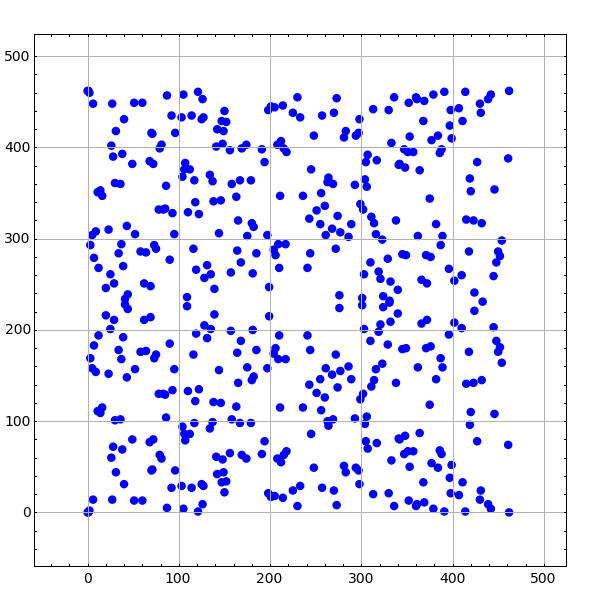Elliptic Curves¶
Cremona’s Databases¶
Cremona’s databases of elliptic curves are part of Sage. The curves up to conductor 10,000 come standard with Sage, and there is an optional download to gain access to his complete tables. From a shell, you should run
sage -i database_cremona_ellcurve
to automatically download and install the extended table.
To use the database, just create a curve by giving
sage: EllipticCurve('5077a1')
Elliptic Curve defined by y^2 + y = x^3 - 7*x + 6 over Rational Field
sage: C = CremonaDatabase()
sage: C[37]['allcurves']
{'a1': [[0, 0, 1, -1, 0], 1, 1],
'b1': [[0, 1, 1, -23, -50], 0, 3],
'b2': [[0, 1, 1, -1873, -31833], 0, 1],
'b3': [[0, 1, 1, -3, 1], 0, 3]}
sage: C.isogeny_class('37b')
[Elliptic Curve defined by y^2 + y = x^3 + x^2 - 23*x - 50
over Rational Field, ...]
There is also a Stein-Watkins database that contains hundreds of millions of elliptic curves. It’s over a 2GB download though!
Bryan Birch’s Birthday Card¶
Bryan Birch recently had a birthday conference, and I used Sage to draw the cover of his birthday card by enumerating all optimal elliptic curves of conductor up to 37, then plotting them with thick randomly colored lines. As you can see below, plotting an elliptic curve is as simple as calling the plot method on it. Also, the graphics array command allows us to easily combine numerous plots into a single graphics object.
sage: v = cremona_optimal_curves([11..37])
sage: w = [E.plot(thickness=10,rgbcolor=(random(),random(),random())) for E in v]
sage: graphics_array(w, 4, 5).show(axes=False)

Plotting Modulo
We can use Sage’s interact feature to draw a plot of an elliptic
curve modulo
In the code below we first define the elliptic curve
E = EllipticCurve('37a')
@interact
def f(p=primes(2,500)):
show(plot(E.change_ring(GF(p)),pointsize=30),
axes=False, frame=True, gridlines="automatic",
aspect_ratio=1, gridlinesstyle={'rgbcolor':(0.7,0.7,0.7)})

Schoof-Elkies-Atkin Point Counting¶
Sage includes sea.gp, which is a fast implementation of the SEA
(Schoff-Elkies-Atkin) algorithm for counting the number of points on
an elliptic curve over
We create the finite field
sage: k = GF(next_prime(10^20))
compute its cardinality, which behind the scenes uses SEA.
sage: E = EllipticCurve_from_j(k.random_element())
sage: E.cardinality() # random, less than a second
99999999999371984255
To see how Sage chooses when to use SEA versus other methods, type
E.cardinality?? and read the source code. As of this writing, it
simply uses SEA whenever
Sage has the world’s best code for computing
In particular, Sage implements Harvey’s improvement on an algorithm of
Mazur-Stein-Tate, which builds on Kiran Kedlaya’s Monsky-Washnitzer
approach to computing
We create the elliptic curve with Cremona label 389a, which is the
curve of smallest conductor and rank
sage: E = EllipticCurve('389a')
sage: E.padic_regulator(5, 10)
5^2 + 2*5^3 + 2*5^4 + 4*5^5 + 3*5^6 + 4*5^7 + 3*5^8 + 5^9 + O(5^11)
sage: E.padic_regulator(997, 10)
740*997^2 + 916*997^3 + 472*997^4 + 325*997^5 + 697*997^6
+ 642*997^7 + 68*997^8 + 860*997^9 + 884*997^10 + O(997^11)
Before the new algorithm mentioned above, even computing a
sage: E.padic_regulator(100003,5) # a couple of seconds
42582*100003^2 + 35250*100003^3 + 12790*100003^4 + 64078*100003^5 + O(100003^6)
The implementation in Sage is mainly due to work of myself,
Christian Wuthrich, and Robert Pollack. We use Sage to compute the
sage: E = EllipticCurve('389a')
sage: L = E.padic_lseries(5)
sage: L
5-adic L-series of Elliptic Curve defined
by y^2 + y = x^3 + x^2 - 2*x over Rational Field
sage: L.series(3)
O(5^5) + O(5^2)*T + (4 + 4*5 + O(5^2))*T^2 +
(2 + 4*5 + O(5^2))*T^3 + (3 + O(5^2))*T^4 + O(T^5)
Bounding Shafarevich-Tate Groups¶
Sage implements code to compute numerous explicit bounds on Shafarevich-Tate Groups of elliptic curves. This functionality is only available in Sage, and uses results Kolyvagin, Kato, Perrin-Riou, etc., and unpublished papers of Wuthrich and me.
sage: E = EllipticCurve('11a1')
sage: E.sha().bound() # so only 2 could divide sha
[2]
sage: E = EllipticCurve('37a1') # so only 2 could divide sha
sage: E.sha().bound()
([2], 1)
sage: E = EllipticCurve('389a1')
sage: E.sha().bound()
(0, 0)
The
Partial results of Kato, Schneider and others on the
sage: E = EllipticCurve('389a1')
sage: sha = E.sha()
sage: sha.p_primary_bound(5) # iwasawa theory ==> 5 doesn't divide sha
0
sage: sha.p_primary_bound(7) # iwasawa theory ==> 7 doesn't divide sha
0
This is consistent with the Birch and Swinnerton-Dyer conjecture,
which predicts that the Shafarevich-Tate group is trivial. Below we
compute this predicted order, which is the floating point number
sage: E.sha().an()
1.00000000000000
Mordell-Weil Groups and Integral Points¶
Sage includes both Cremona’s mwrank library and Simon’s 2-descent GP scripts for computing Mordell-Weil groups of elliptic curves.
sage: E = EllipticCurve([1,2,5,17,159])
sage: E.conductor() # not in the Tables
10272987
sage: E.gens() # a few seconds
[(-3 : 9 : 1), (-3347/3249 : 1873597/185193 : 1)]
Sage can also compute the torsion subgroup, isogeny class, determine images of Galois representations, determine reduction types, and includes a full implementation of Tate’s algorithm over number fields.
Sage has the world’s fastest implementation of computation of all
integral points on an elliptic curve over
sage: E = EllipticCurve([1,2,5,7,17])
sage: E.integral_points(both_signs=True)
[(1 : -9 : 1), (1 : 3 : 1)]
A very impressive example is the lowest conductor elliptic curve of
rank
sage: E = elliptic_curves.rank(3)[0]
sage: E.integral_points(both_signs=True) # less than 3 seconds
[(-3 : -1 : 1), (-3 : 0 : 1), (-2 : -4 : 1), (-2 : 3 : 1), ...(816 : -23310 : 1), (816 : 23309 : 1)]
The algorithm to compute all integral points involves first computing the Mordell-Weil group, then bounding the integral points, and listing all integral points satisfying those bounds. See Cohen’s new GTM 239 for complete details.
The complexity grows exponentially in the rank of the curve. We can
do the above calculation, but with the first known curve of rank
sage: E = elliptic_curves.rank(4)[0]
sage: E.integral_points(both_signs=True) # about a minute
[(-10 : 3 : 1), (-10 : 7 : 1), ...
(19405 : -2712802 : 1), (19405 : 2693397 : 1)]
Evaluation¶
We next compute with the complex
of
sage: E = EllipticCurve('389a1')
sage: L = E.lseries()
sage: L
Complex L-series of the Elliptic Curve defined by
y^2 + y = x^3 + x^2 - 2*x over Rational Field
sage: L(1) #random due to numerical noise
-1.04124792770327e-19
sage: L(1+I)
-0.638409938588039 + 0.715495239204667*I
sage: L(100)
1.00000000000000
Taylor Series¶
We can also compute the
Taylor series of
sage: E = EllipticCurve('389a1')
sage: L = E.lseries()
sage: Ld = L.dokchitser()
sage: Ld.taylor_series(1,4) #random due to numerical noise
-1.28158145691931e-23 + (7.26268290635587e-24)*z + 0.759316500288427*z^2 - 0.430302337583362*z^3 + O(z^4)
GRH¶
The Generalized Riemann Hypothesis asserts that all nontrivial zeros
of
sage: L.zeros(10)
[0.000000000, 0.000000000, 2.87609907, 4.41689608, 5.79340263,
6.98596665, 7.47490750, 8.63320525, 9.63307880, 10.3514333]